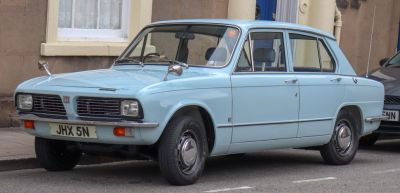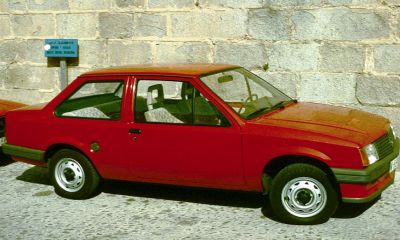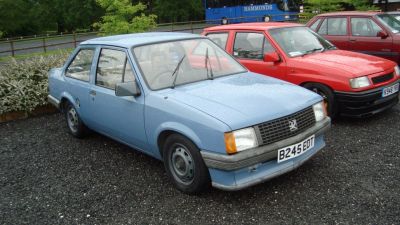 1987 Opel Corsa A Sedan (facelift 1987) Dimensions, Size & Specs
1987 Opel Corsa A Sedan (facelift 1987) Dimensions, Size & Specs
Measurements of the 1987 Opel Corsa A Sedan, engineered for optimal performance and comfort
| Dimensions | |
|---|---|
| Length: | 3955 mm155.7 in13.0 ft |
| Width: | 1540 mm60.6 in5.1 ft |
| Height: | 1360 mm53.5 in4.5 ft |
| Ground Clearance: | 140 mm5.5 in0.5 ft |
| Trunk Capacity: | 430 liter15.2 cu ft |
| Weight Specifications | |
| Curb Weight: | 755-870 kg1664-1918 lbs |
| Maximal permitted Weight: | 1235-1330 kg2723-2932 lbs |
| Tire Specifications | |
| Rims Sizes: | 13-inch rims:
|
| Tire Sizes: |
|
The Opel Corsa A Sedan, facelifted in 1987 and produced until 1990, represents a practical and compact sedan option from Opel in the late 1980s. Measuring 3955 mm (155.7 inches) in length, 1540 mm (60.6 inches) in width, and 1360 mm (53.5 inches) in height, this vehicle fits well within the compact car segment, offering maneuverability and ease of parking in urban environments. The facelift brought subtle updates to the styling while maintaining the car's functional design.
Weighing between 755 and 870 kilograms (1664 to 1918 pounds) in curb weight and with a maximum weight rating ranging from 1235 to 1330 kilograms (2723 to 2932 pounds), the Corsa A Sedan is light and efficient. This weight advantage contributes to nimble handling and better fuel economy, factors that made it appealing for daily commuting. Ground clearance is 140 mm (5.5 inches), providing modest clearance suitable for city roads and light rural use without compromising stability.
The luggage capacity of this model is 430 liters (15.2 cubic feet), which is impressive for a compact sedan, making it practical for small families or individuals requiring reasonable cargo space. The 1987 facelift model rides on rims sized between 13.5J x 14, accommodating tire sizes from 145/70 R13 to 165/70 R13 and 165/65 R14, offering a balance of comfort and modest road grip.
Overall, the Opel Corsa A Sedan facelift (1987-1990) blends compact dimensions with effective interior and luggage space, making it a practical choice for drivers seeking an affordable, reliable sedan from the era. Its moderate curb weight and size ensure it remains an easy-to-handle vehicle, perfect for urban driving and efficient use of space.
Discover the standout features that make the 1987 Opel Corsa A Sedan a leader in its class
Have a question? Please check our knowledgebase first.
The Opel Corsa A Sedan (facelift 1987) has an overall length of 3955 mm (155.7 inches), a width of 1540 mm (60.6 inches), and a height of 1360 mm (53.5 inches). These compact dimensions make it suitable for urban driving and parking in tighter spaces, reflecting its design as a small but practical sedan for the late 1980s.
The curb weight of the Opel Corsa A Sedan (1987 facelift) ranges from 755 kg to 870 kg (approximately 1664 to 1918 lbs). The maximum permissible weight is between 1235 kg and 1330 kg (about 2723 to 2932 lbs). This weight range indicates a lightweight, fuel-efficient small sedan designed for city and suburban use.
The luggage capacity of the Opel Corsa A Sedan (1987 facelift) is 430 liters (about 15.2 cubic feet). This is a generous amount of space for a sedan of its size, making it practical for daily errands, small family trips, or transporting larger grocery loads, despite its compact overall dimensions.
The Opel Corsa A Sedan (1987 facelift) features a ride height/ground clearance of 140 mm (approximately 5.5 inches). This modest ground clearance is typical for compact sedans designed for paved roads, offering a balance between easy entry and exit, stable handling, and sufficient clearance for minor road bumps and urban obstacles.
The facelifted Opel Corsa A Sedan uses rim sizes of 13.5J x 14, with tire size options including 145/70 R13, 165/65 R14, and 165/70 R13. These sizes reflect the compact nature of the vehicle and contribute to a comfortable ride and good grip suitable for city and suburban driving conditions.
Yes, the Opel Corsa A Sedan (facelift 1987) comfortably fits into a standard garage. With a length of 3955 mm (155.7 inches) and width of 1540 mm (60.6 inches), it is smaller than many modern vehicles, ensuring ample space for opening doors and maneuvering inside a typical single-car garage. The compact size is advantageous for owners with limited parking space.
The 1987 facelift of the Opel Corsa A Sedan mainly involved aesthetic and minor mechanical updates rather than a complete change in size. The dimensions remained largely similar to the original Corsa A Sedan produced from 1982 to 1987, maintaining its compact length of approximately 3955 mm, width around 1540 mm, and height near 1360 mm. This ensured continuity in its urban-friendly size while benefiting from design improvements.
The Opel Corsa A Sedan (1987 facelift) holds a competitive position among small sedans of the late 1980s. With a length of 3955 mm, width of 1540 mm, and height of 1360 mm, it is comparable in size to models like the Ford Fiesta Mk2 and Volkswagen Polo Mk2 sedans. Its slightly larger luggage capacity of 430 liters also offers a practical advantage. Its relatively lightweight build contributed to nimble driving and fuel efficiency, making it an appealing choice in the small sedan segment.
The Opel Corsa A Sedan facelifted in 1987 is known for its nimble and responsive handling, attributed to its lightweight design (755-870 kg curb weight) and compact dimensions. It offers a balanced ride suitable for city driving with decent ground clearance of 140 mm, making it capable on uneven surfaces without sacrificing stability. The suspension is tuned for comfort and practicality rather than sporty driving, appealing mainly to urban commuters and small families.
The Opel Corsa A Sedan facelift introduced during 1987 featured a range of small-displacement, fuel-efficient engines typical of the era, including 1.0L and 1.2L petrol inline-4 engines. These engines offered modest power outputs suited to urban and suburban driving needs, prioritizing reliability and economical fuel consumption. The facelift model retained the practical, no-frills approach of its predecessor with an emphasis on affordability and ease of maintenance.
Discover similar sized cars.

| Production: | 1970-1977 |
|---|---|
| Model Year: | 1970 |
| Length: | 3965 mm156.1 in |
| Width: | 1568 mm61.7 in |
| Height: | 1372 mm54.0 in |

| Production: | 1982-1986 |
|---|---|
| Model Year: | 1982 |
| Length: | 3975 mm156.5 in |
| Width: | 1620 mm63.8 in |
| Height: | 1390 mm54.7 in |

| Model Year: | 1983 |
|---|---|
| Length: | 3955 mm155.7 in |
| Width: | 1540 mm60.6 in |
| Height: | 1360 mm53.5 in |

| Production: | 1983-1993 |
|---|---|
| Model Year: | 1983 |
| Length: | 3955 mm155.7 in |
| Width: | 1541 mm60.7 in |
| Height: | 1358 mm53.5 in |
